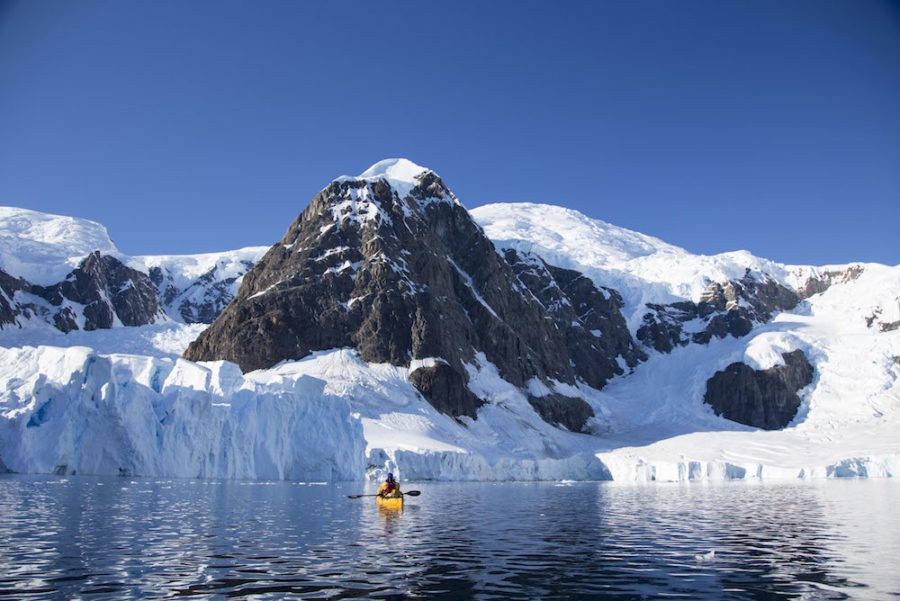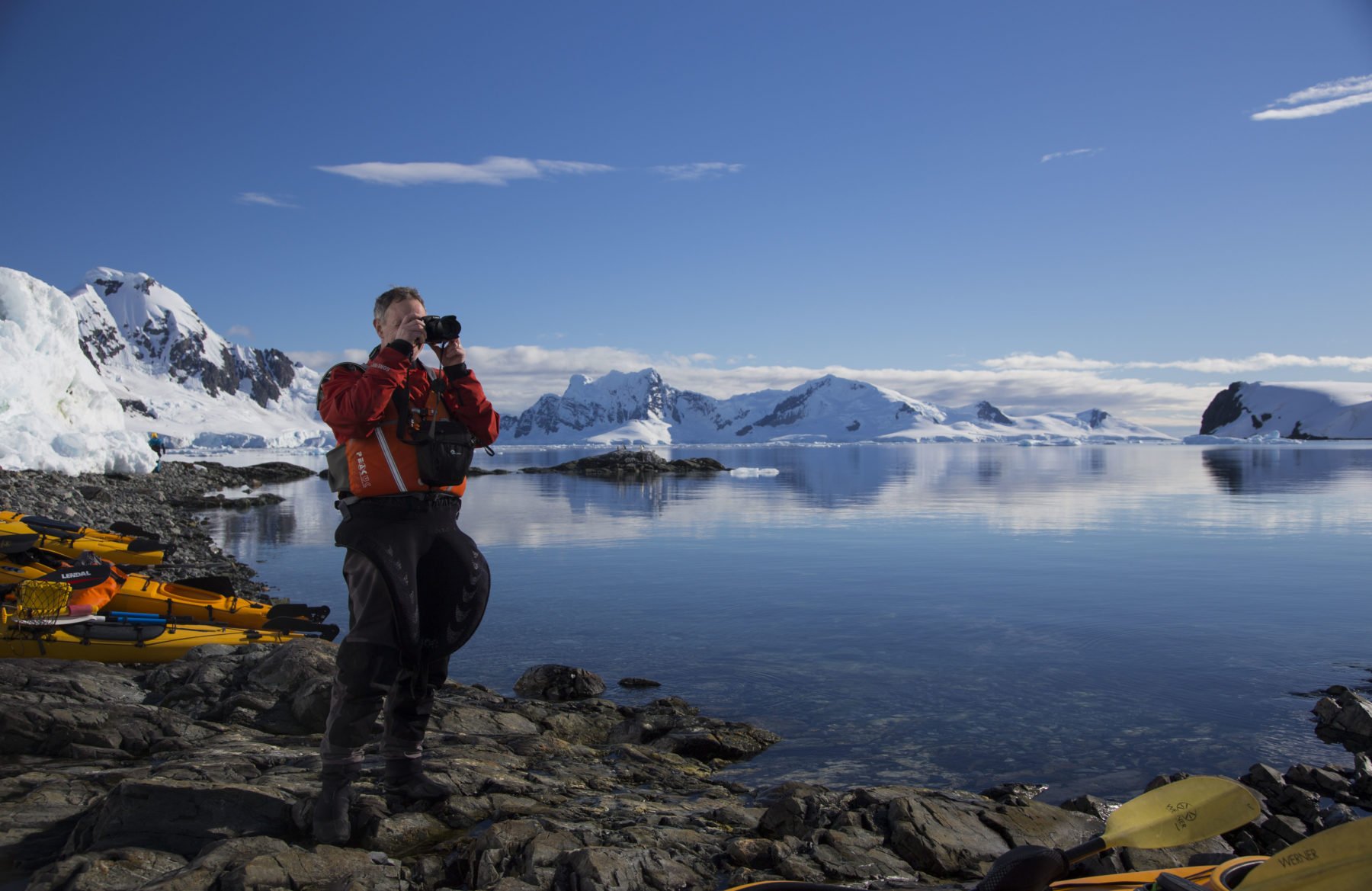In the footsteps of Shackleton

Long before the penguin rookery at Salisbury Plain on the subantarctic island of South Georgia comes into view, it imprints itself on my olfactory system. The collective odour of 250,000 king penguins wafts across the Bay of Isles to where my ship is anchored for the night, ahead of a beach landing scheduled for early the next morning.
Despite the pungent welcome, I can’t wait to get ashore. I’ve yearned to see this place ever since I saw a photographic slide of it taken many years ago by New Zealand polar explorer Colin Monteath. Shortly after dawn I’m there, cautiously stepping around the edge of a vast throng of elegant metre-tall king penguins in smart black-and-white plumage with vibrant daubs of orange-yellow around the head and neck.
Among the adults are countless partially fledged subadults and recently hatched fluffy chicks. The birds cover every square metre of the grey shingle beach for as far as my eye can see and spread up onto green slopes rising in the distance, a serrated range of glaciated mountain peaks providing a dramatic backdrop.
Whistles, whoops and alarm calls compete with the sound of crashing waves. Giant southern petrels stalk the beach, ready to prey on unguarded penguin chicks. Hundreds of play-fighting juvenile Antarctic fur seals challenge unwary tourists along the shoreline, while a few elephant seal pups are sighted, snoozing and snoring, oblivious to the surrounding spectacle. The sight, sound and smell of a quarter of a million penguins create a sensory overload that leaves me speechless.
This is surely one of the planet’s greatest wildlife encounters.
Antarctic appeal
Whether it’s the prospect of natural spectacles such as Salisbury Plain, the lure of ice formations whose grandeur and scale defy description, or simply the need to venture beyond comfort zones, it’s hard to pin down what drives the desire to travel to Antarctica for a holiday. It’s a cold, inhospitable and potentially perilous place that can only be reached after long flights and turbulent sea crossings.
Whatever it is that draws people here, it almost certainly includes the romance of the Heroic Era – that roll call of names such as Shackleton, Scott, Amundsen and Mawson whose exploits are etched into the imagination of generations and whose legends only seem to grow with passing years. The chance to follow in their footsteps, bring their journal entries to life and see those old sepia photos realised in living colour has brought many a visitor to this extreme region of the world. My Antarctic voyage is no exception.
I’m following in the footsteps of Ernest Shackleton on an Australian Geographic Society expedition. It’s early autumn and with me is a group of 50 eager would-be polar adventurers – Australians mostly, including many AG subscribers, but among them are Kiwis and a few guests from the UK, USA, Canada and Ireland.
There’s an expert drew and team of expedition leaders, naturalists and guides, and all are united by a willingness to participate eagerly in everything that a small-ship expedition such as this has to offer during weeks of adventure and discovery as we journey south from Patagonia across the notorious Drake Passage towards the Antarctic Peninsula. We’ll eventually intersect with Shackleton’s journey from the Weddell Sea to Elephant Island, turning northeast across the Scotia Sea to South Georgia and eventually back west to the Falkland Islands.

Among us are four experienced climbers – two men and two women – who will be retracing Shackleton’s hazardous traverse of South Georgia from King Haakon Bay on the south-west coast to Stromness on the north. Whenever possible, they’re off the ship at first light to climb precipitous, icy slopes and crevassed glaciers to prepare for the big challenge. Others take to the water in kayaks led by guides, while most board a fleet of inflatable rafts, or Zodiacs, to land on the shorelines of the Antarctic Peninsula.
I’m among the kayakers, although I alternate between the kayaks and Zodiacs, keen to be among the growing camaraderie of the big group. I’m a sunny day paddler at best, used to the shallow tepid waters of Sydney’s rivers and inlets. But the chance to try my skills in these choppy, chilly waters is too good to resist.
On course for adventure
Our route along the Antarctic Peninsula delivers a surprising variety of experiences, environments and wild encounters. We meet engaging little chinstrap and gentoo penguins on Aitcho Island in the South Shetland archipelago where what looks from afar like a dusting of fine powdery snow turns out to be feathers from moulting gentoos.
Our ship threads its way through tricky Neptune’s Bellows, a narrow cleft in the outer ramparts of Deception Island, to enter the caldera of this active volcano that erupted as recently as 1969. It’s provided refuge for many a vessel tossed about in the surrounding wild seas. Protected from the elements, we explore remnants of whaling days here and the hangar and runway from where Hubert Wilkins made the first ever Antarctic flight, in 1928.
After days of island hopping, we eventually come ashore on the continent itself at Paradise Bay. The warm sun beats down as I join the kayakers to paddle around this gleaming harbour where blindingly white glacier-bearing peaks are perfectly mirrored in the still waters under a deep blue sky.

Such unusually balmy conditions mean we are on for that dreaded rite of passage, the ‘polar plunge’. Later that morning a whole bunch of passengers and crew, me included, leap like lemmings into the near-freezing waters.
Our momentary discomfort pales in comparison to the suffering that must have been endured by the early explorers. It’s not long before we’re tracking in their wake as we head towards Elephant Island, well-known to devotees of Shackleton as the place from where, in April 1916, he set sail with five companions in the small (6.75m) lifeboat James Caird towards South Georgia, 1500km away.
It’s too rough to land but our captain skilfully steers us in close to a grim spit of stony beach, now called Point Wild, which served as home to 22 stranded crewmen for more than four months.
As we prepare to make our own crossing to South Georgia, the Southern Ocean finally unleashes her fury and we sail into a force 9 gale. We brave a couple of bumpy nights but complaints are kept to a minimum as we reflect on the privations of Shackleton and his men as they sailed these rough seas for 16 desperate nights in that leaky lifeboat 100-plus years earlier.
Wild and free
We awake in the splendour of King Haakon Bay, on the south-west side of South Georgia, close to where the James Caird finally found a safe landing. Small groups of king penguins can be seen along the shore, the first we’ve seen this trip. They are, undoubtedly, the handsomest of all penguin species and once we’re ashore they size us up, keen to get a closer look at this bunch of new arrivals.
The wind funnels down the glaciers along the steep, jagged mountain chain that runs the length of the island as we step through the mounds of green tussock grass that characterise South Georgia’s lower hills and valleys. Almost every tussock contains a sweet little fur seal pup, younger and more timid than those we’ll meet later at Salisbury Plain. We stumble across huddles of moulting adult elephant seals hidden among the grasses, announcing their irritation at our presence with belches, groans and flatulent outbursts.
We spot tiny South Georgia pipits darting in the surf. These delicate brown songbirds look out of place in the rugged polar terrain but they’re tough little creatures that have been the beneficiary of an ambitious pest-eradication project run by the South Georgia Heritage Trust to rid the island of introduced rodents, which drove them to the brink of extinction. The pipits have bounced back in great numbers and we spot them all over the island. Fur seals, once decimated by the sealing industry, have also recovered and are said to number some 3 million on South Georgia.

The mountaineers set off on their overland trek in the footsteps of Shackleton, Tom Crean and Frank Worsley. We meet them again a couple of days later and join them for the final 7km of their traverse just above the old whaling station at Stromness but, meanwhile, our ship heads off to explore the indented coastline of this unique biological hotspot, on the lookout for whales, nesting wandering albatross and other penguin species, notably macaronis, of which there are more than 1 million pairs on the island.
Such richness of life is the result of South Georgia’s geographical position. The 170km-long crescent-shaped isle lies just south of the Antarctic Convergence, where warmer subtropical waters meet colder Antarctic waters. Its proximity to the South American mainland and milder climate provide an environment where a great variety of flora and fauna are able to colonise and thrive.
The weather here is mostly cold, windy and wet but occasionally the clouds dissipate, the winds drop and the sun comes out. Summer temperatures above 26oC have been recorded here, albeit rarely, and the daily temperature averages about 1.8oC. During our week of exploration the sun shines much of the time and by the time we’re toasting Ernest Shackleton, ‘The Boss’, at his final resting place in Grytviken cemetery, we’ve divested ourselves of down jackets, gloves and hats and enjoy exploring the old whaling station in warm afternoon sunshine.

What an adventure we’ve had. Antarctica has been top of my wish list for 20 years but this isn’t somewhere you simply tick off. It’s impossible not to be changed by this environment or the explosion of life here. Steeped in the legacy of the Heroic Era and rich in the wildness of a place far removed from the ravages of humankind, but not immune to them, we have been privileged to set foot in these precious places.
No, I’m not ticking it off. It’s the last frontier – a truly wild and, mostly, pristine continent and once you let it into your heart, it will undoubtedly call you back again and again.
Our Antarctica & Falklands journey with Hurtigruten Expeditions begins on 21 November 2022, aboard the world’s first hybrid-powered ship MS Roald Amundsen. Don’t miss out. Book your cabin now. Find out more about this incredible expedition here.

